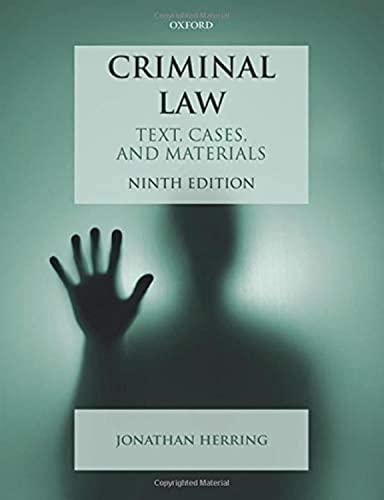Question
Who is in charge of how, when, and which legislation is passed? Then compare it to your initial post and think about whether your perspective
Who is in charge of how, when, and which legislation is passed? Then compare it to your initial post and think about whether your perspective has changed and why.
My initial post:
Theconflict modelincriminal justiceoffers an alternative perspective on the causes ofcrimeand the operation of thecriminal justice system. Rooted in sociological theory, the conflict model posits that crime arises from social and economic conflict within society rather than merely being the result of individual choices or inherent criminal tendencies. This viewpoint underscores the influence of power dynamics, inequality, and societal structures on crime rates andcriminal behavior. A conflict model is where the criminal justice system seems to be being used by the ruling class to control the lower class.
The conflict model in criminal justice provides a different lens through which to understand crime, focusing on social and economic conflict as the underlying cause. It highlights the role of power and inequality in perpetuating crime and criticizes the traditional criminal justice system for its bias and disproportionate targeting of marginalized groups.
As a response, proponents of this model advocate for alternatives such as restorative justice and social programs that tackle the root causes of crime. Understanding the conflict model can offer valuable insights into the complex interplay of societal structures, power dynamics, and crime and inform more holistic and equitable approaches to criminal justice.
The consensus model is where we have a model of criminal lawmaking that assumes that members of society agree on what is right and wrong and that law is the codification of agreed-upon social values. The consensus model suggests that the system operates best when there is a consensus on what behaviors are consideredcriminaland thepenaltiesfor those behaviors. Contrary towidely held belief, the criminal justice system is based on consensus, rather thandisagreement, about what constitutes criminal conduct and how to deal with it.
The consensus model implies thatlaws reflect shared social values and that the criminal justice system exists to enforce those sharedsocial values. There are, of course, instances of disagreement within the system, such as sentencing and legal interpretations. Theconsensus model is often used to describe the American criminaljustice system.
The difference between the conflict model and the consensus model is that the consensus model is viewed as a whole; society agrees on a judgment or what is right and what is wrong; and the conflict model is where the ruling class controls the lower class (Adler, F. 2021). In the conflict model, the ruling class also has control over law enforcement, whereas in the consensus model, there is a rule book that determines the sentence of an individual that goes beyond normal behavior. The consensus model is designed to create laws for the greater good, and the conflict model believes that there needs to be a higher power, or a higher group, that has all authority over the law and the lawmakers.
Both models deal with power and have control over society; they are in charge of making decisions, andwhile one is settled on the majority, the other runs through the upper class. The model that fits with the ideological underpinnings of the U.S. justice system is the consensus model. This model more closely represents the structure of our government. For example, we have lawmakers, the legislature, judges, attorneys, law enforcement (police), and criminologists. When all of these branches come together and brainstorm the crimes that are being committed, they produce the best course of action against that individual or group and attempt to prevent the crime from being committed by that person again.
References:
Adler, F., Laufer, W., & Mueller, G. O. (2021).Criminology(10th ed.). New York, NY: McGraw-Hill Education, ISBN-13:9781260837001
Step by Step Solution
There are 3 Steps involved in it
Step: 1

Get Instant Access to Expert-Tailored Solutions
See step-by-step solutions with expert insights and AI powered tools for academic success
Step: 2

Step: 3

Ace Your Homework with AI
Get the answers you need in no time with our AI-driven, step-by-step assistance
Get Started


